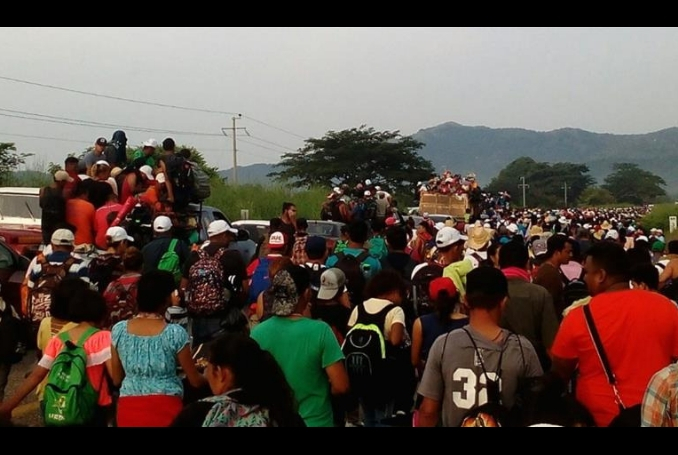
By Benay Blend
In the title quote, the words refer to a collection of readings from several years of the Palestine Festival of Literature, an annual literary event that allows performers to interact with Palestinians on their home ground, despite the many barriers in doing so. For some Palestinians, the U.S.-Mexico border feels the same.
When Ahmed Abu Artema, Gazan poet and lead organizer of the Great Return March, traveled to the Southwest in March 2018 he visited the border. Recalling the same tragedy in Rafah, an area where a border fence also splits families apart, he declared:
“Borders are a declaration of moral and political failures.”
For both Palestinians at the Gaza fence and refugees from South of the border seeking entry into the United States, borders represent a form of imperialism, a line that excludes colonized populations while also denying citizenship privileges and worker’s rights.
There are many similarities, then, between both borders. The most obvious appears in tactics that have been exported by Israel to the United States. Such procedures left many Americans shocked when Trump first voiced them but closer inspection shows that they have long been used by America’s closest ally.
As Michael Arria notes, when Trump suggested shooting migrants in the legs in order to halt their progress across the Southern boundary, he was merely borrowing a page from Israeli snipers at the Gaza border who target legs over any other part of the body. Trump appears to have taken a page out of a horror movie when he added that he “wanted the [border] wall electrified, with spikes on top that could pierce human flesh,” as reported by Arria, who writes that the President even “floated the idea of a trench in front of the wall that contained alligators.” But again, given the inhumane treatment that Palestinians experience at the hands of Israel, Trump’s pronouncements do not seem all that extreme.
As the increase in migration creates new communities, so also does the language of ‘borders’ and ‘Diasporas’ acquire new meaning. For example, in Borderlands / La Frontera (1987), Gloria Anzaldúa, writing from her own experiences growing up in the Southwest borderlands, constructs a natural connection between women like herself (los atravesados, the “mongrel, the mulato, the half-breed, the half dead”) and others who feel marginalized by society.
Conceptualizing the U.S.-Mexico boundary as a metaphorical space, Anzaldúa believed that female border crossers often negotiate in ways that allow them to claim contested spaces as their own. For Summer Masoud, a Palestinian American who grew up on the US-Mexico border, this concept is particularly relevant.
Because of her ethnicity, she understands that the concept of walls and borders for Palestinians is all common. Her father, who immigrated to the U.S. for school, stayed on in El Paso where he has worked as a civil engineer for over 30 years. Nevertheless, he feels at home:
You wouldn’t think of El Paso, Texas, and Palestine as having anything in common, but you’d be surprised how similar these two regions are. On the surface, they look the same. My father often jokes that’s why he chose El Paso to begin with. Both areas feature a desert landscape with craggy rocks and spindly shrubs.
Beyond the commonalities of landscape, though, both regions are settler-colonial societies that have constructed borders to keep the unwanted outside altogether and/or at the very least keep them in their place.
Like Anzaldúa, Masoud has created for herself a dual identity, a blending of “two identities,” she says, “that are in conflict” with mainstream society’s perception of who she ought to be. In the U.S., Latinos are perceived as “invaders” who seek to destroy the American way of life.
Despite the fact that many have lived in the Southwest for centuries, much longer than the true invaders, the Anglos, this false perception has been constructed partly to maintain the desired demographics of the Euro-American majority who are citizens.
In Palestine, the Indigenous are viewed as “terrorists” who seek to destroy Israeli’s sense of security in their newly adopted land. Because of El Paso’s multiethnic population, Summer and her family have enjoyed a measure of freedom that perhaps they would not have had at home.
Growing up almost my entire life on the El Paso/Juarez border has shown me the actuality of the situation. El Paso and Juarez are sister cities and the border blends to create a culture of harmony between Mexicans and Americans here. Conversations switch fluidly between English and Spanish.
Pesos and dollars can be interchanged in many shops on both sides of the downtown international bridge. Most people in this region would agree that it is our relationship with Mexico that makes our city one of the safest in the United States.
Nevertheless, Anzaldúa’s theory of cultural intersections can only go so far. As Ramzy Baroud observes, there are increasing aspects of border life in the United States that are troubling.
In particular, Israel has been exporting “surveillance technologies, walls, border monitoring equipment, and violent tactics” to beef up border security as well as subdue activists who protest his policies. “Israel’s illegal tactics are now the model through which the US plans to police its cities, monitor its borders and define its relationship with its neighbors,” Baroud explains, an exchange that makes Anzaldúa’s positive concept of the borderlands at best outdated.
Beyond pointing out the obvious concern over Israel’s export of the Occupation to the United States, what are the advantages of comparative studies between the two borders?
Drawing on Steven Salaita’s concept of “reciprocal communalism,” focusing on such relationships, he says, “move[s] beyond dialogue into a more defined cross-cultural political consciousness”. While tied to their space of homeland, Palestinians and border activists elsewhere demonstrate a commitment to mutual liberation founded on reciprocal opposition to colonial power wherever it exists.
For example, The U.S. Campaign for Palestinian Rights reports that on Indigenous People’s Day in 2017 a delegation of leaders in the immigration rights movement arrived in Palestine to learn about the Israeli Apartheid Wall. The delegation included journalists, students, and activists from both sides of the US/Mexico border wall, including members of the Tohono O’odham tribe whose land is divided by the barrier.
From the meeting, the delegates hoped to share information as well as build a world-wide movement against such borders. As Cynthia Franklin, co-editor of “Life in Occupied Palestine” notes, sumoud is a Palestinian tradition, but it gains strength through international solidarity, certainly as demonstrated here among activists at both borders.
– Benay Blend received her doctorate in American Studies from the University of New Mexico. Her scholarly works include Douglas Vakoch and Sam Mickey, Eds. (2017), “’Neither Homeland Nor Exile are Words’: ‘Situated Knowledge’ in the Works of Palestinian and Native American Writers”. She contributed this article to The Palestine Chronicle.
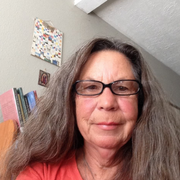
– Benay Blend earned her doctorate in American Studies from the University of New Mexico. Her scholarly works include Douglas Vakoch and Sam Mickey, Eds. (2017), “’Neither Homeland Nor Exile are Words’: ‘Situated Knowledge’ in the Works of Palestinian and Native American Writers”. She contributed this article to The Palestine Chronicle.

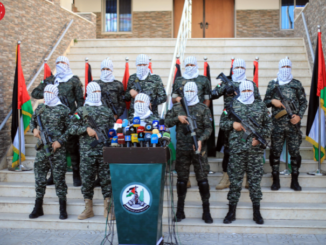
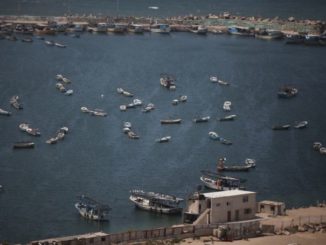
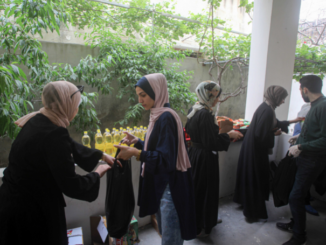




I wish more of what you talk about here regarding both Palestinian plight and the Mexican refugees could be seen and heard by everyone. Writer in the New Yorker mentioned this week that she didn’t understand why so few people knew anything about the camps in WW2. The absence of information in the standard high school text book and the lack of information elsewhere is the main reason for the German camps and for the Palestinians and Mexican refugees. Trump tried earlier to obtain possession of a large piece of land in northern California which he could as a detention camp. He seems to have forgotten(??) they are not allowed since WW2. Anyone not white, blond(orange)hair and blue eyes==00.